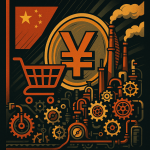Key Points
- The upcoming integration of the RMB stock trading counter into Stock Connect, confirmed by Hong Kong’s SFC, is expected to significantly boost trading volume by allowing mainland investors to directly trade Hong Kong-listed stocks in RMB.
- The news triggered a powerful market reaction: A-Shares saw the ChiNext Index soar by 2.39%, and total turnover in Shanghai and Shenzhen exceeded ¥1.47 trillion RMB ($202.9 billion USD).
- Despite the dual-counter model launching in June 2023, the RMB counter currently accounts for less than 2% of affected stocks’ total trading volume (¥49.18 billion RMB vs. HKD 22.52 trillion), highlighting the potential for growth.
- Southbound capital from mainland China has been pouring into Hong Kong, with a net purchase of HKD 12.067 billion on July 7, 2025, and over ¥78.6 billion RMB ($10.8 billion USD) in net inflows over the past month.
- Beyond Stock Connect, factors like China’s “anti-involution” policies, a favorable low-interest-rate environment, and historically low short-selling pressure contribute to a strong bull case for Hong Kong stocks.

The China-Hong Kong **RMB stock trading counter** is officially getting plugged into the Stock Connect scheme, and the market is absolutely ripping in response.
This isn’t just a minor update; it’s a fundamental shift that’s injecting a massive wave of optimism—and capital—into both A-shares and H-shares.
Let’s break down what’s happening, why it matters, and where the opportunities are.
The Green Light: SFC Confirms RMB Counter is Coming Soon
On July 8, 2025, Julia Leung (Liang Fengyi 梁凤仪), the CEO of Hong Kong’s Securities and Futures Commission (SFC), dropped the news at the Bond Connect Anniversary Forum 2025.
She confirmed that technical preparations for adding the **RMB stock trading counter** into Stock Connect are running smoothly.
The key takeaway? Implementation details are expected to be announced “soon.”
Leung expects that once a clear timeline is out, more companies will rush to issue RMB-denominated stock counters, which will massively boost trading volume from southbound capital.

Resume Captain
Your AI Career Toolkit:
- AI Resume Optimization
- Custom Cover Letters
- LinkedIn Profile Boost
- Interview Question Prep
- Salary Negotiation Agent

Markets Explode: A-Shares and H-Shares Surge on the News
The market reaction was immediate and powerful. As soon as the news hit, both mainland and Hong Kong markets took off.
Here’s a quick snapshot of the aftermath:
- 📈 A-Shares Rally: All three major A-share indices closed in the green. The **ChiNext Index** led the charge, soaring by 2.39%.
- 💰 Massive Trading Volume: Total turnover across the Shanghai and Shenzhen markets blew past ¥1.47 trillion RMB ($202.9 billion USD). That’s an increase of ¥247.6 billion RMB ($34.2 billion USD) from the previous day.
- 🇭🇰 Hong Kong Tech Jumps: The **Hang Seng Tech Index** surged by nearly 2%, while the broader Hang Seng Index climbed 1.09%.
- 🔥 Over 4,200 Stocks Up: Across the board, over 4,200 individual stocks rose, showing widespread market confidence.

Why This Is a Game-Changer for Market Liquidity
So, what’s the big deal? It all comes down to liquidity.
The Hong Kong Stock Exchange (HKEX) launched its “dual-counter model” back in June 2023.
This allowed 24 major stocks, like Tencent (Tengxun 腾讯) and Alibaba (Alibaba 阿里巴巴), to be traded in both Hong Kong Dollars (HKD) and Chinese Yuan (RMB).
But here’s the problem:
The adoption of the RMB counter has been incredibly slow.
Public data reveals a massive gap:
- HKD Counter Trading Volume (since June 2023): HKD 22.52 trillion
- RMB Counter Trading Volume (since June 2023): ¥49.18 billion RMB ($6.8 billion USD)
That means the RMB counter currently accounts for less than 2% of the total trading volume for these stocks.
By integrating the RMB counter into the **Stock Connect**, mainland investors can now directly trade these Hong Kong-listed stocks in their native currency (RMB) without dealing with foreign exchange complexities.
This is expected to unlock a torrent of new capital and significantly boost the liquidity and appeal of RMB-denominated assets in Hong Kong.
In the short term, dual-counter giants like Tencent (Tengxun 腾讯) and Alibaba (Alibaba 阿里巴巴) are poised to benefit most. Long-term, this move strengthens Hong Kong’s role as a key offshore RMB hub.
- ChiNext Index: Soared by 2.39%
- Total A-share Turnover (Shanghai & Shenzhen): ¥1.47 trillion RMB (~$202.9 billion USD)
- Increase in A-share Turnover from previous day: ¥247.6 billion RMB (~$34.2 billion USD)
- Hang Seng Tech Index: Surged by nearly 2%
- Hang Seng Index: Climbed 1.09%
- Individual Stocks Up: Over 4,200 stocks increased

Find Top Talent on China's Leading Networks
- Post Across China's Job Sites from $299 / role, or
- Hire Our Recruiting Pros from $799 / role
- Qualified Candidate Bundles
- Lower Hiring Costs by 80%+
- Expert Team Since 2014
Your First Job Post

Southbound Capital is Already Pouring In
Smart money isn’t waiting around. **Southbound capital**—money flowing from mainland China into Hong Kong’s market—has been on a buying spree.
Just look at the numbers from Choice Financial Data (Choice Shuju Choice数据):
- On July 7, 2025, southbound capital made a net purchase of HKD 12.067 billion in Hong Kong stocks—the largest single-day net purchase since May 6.
- In the past month alone, net inflows have exceeded ¥78.6 billion RMB ($10.8 billion USD).
Where is this money going? Straight into the dual-counter leaders:
- Meituan-W (Meituan-W 美团-W): HKD 717 million net purchase
- Tencent Holdings (Tengxun控股 腾讯控股): HKD 542 million net purchase
- Kuaishou-W (Kuaishou-W 快手-W): HKD 530 million net purchase
- SMIC (Zhongxin Guoji 中芯国际): HKD 511 million net purchase
- Innovent Biologics (Xinda Shengwu 信达生物): HKD 247 million net purchase
- Guotai Junan International (Guotai Jun’an Guoji 国泰君安国际): HKD 204 million net purchase
- Net Purchase (July 7, 2025): HKD 12.067 billion (largest single-day since May 6)
- Net Inflows (Past Month): Over ¥78.6 billion RMB (~$10.8 billion USD)

ExpatInvest China
Grow Your RMB in China:
- Invest Your RMB Locally
- Buy & Sell Online in CN¥
- No Lock-In Periods
- English Service & Data
- Start with Only ¥1,000

The Bull Case: Favorable Policies and Macro Tailwinds
Beyond the Stock Connect news, other factors are creating a perfect storm for a potential bull run in Hong Kong stocks.
1. “Anti-Involution” Policies
Chen Guo (Chen Guo 陈果), Chief Strategist at Eastmoney Securities (Dongfang Caifu Zhengquan 东方财富证券) Research Institute, points to China’s “anti-involution” policies.
These policies are designed to eliminate inefficient, backward production capacity, which in turn should improve the return on equity (ROE) for leading companies in those sectors.
Historically, this trend sees valuations rise first, followed by earnings improvements. The policy itself drives the initial stock price surge.
2. A Favorable Rate Environment
The external macro picture is also looking good.
Chen Guo notes that with the U.S. likely in a rate-cutting cycle, the Hong Kong Monetary Authority (HKMA) will have flexibility.
This means Hong Kong’s low-interest-rate environment is likely to stick around, with less risk of a liquidity crunch.
3. Low Short-Selling Pressure
To top it off, the proportion of short-selling in Hong Kong stocks has fallen to a historically low level.
This suggests that there’s less downward pressure on the market, giving it more room to run.

The Bottom Line
The stage is set for a new era in the Hong Kong stock market.
The impending inclusion of the **RMB stock trading counter** in Stock Connect is the catalyst, but it’s supported by strong capital inflows, strategic policy shifts in the mainland, and a favorable global macro environment.
For investors, founders, and anyone watching Chinese tech, this is a pivotal moment that signals deeper financial integration and fresh opportunities for growth.






